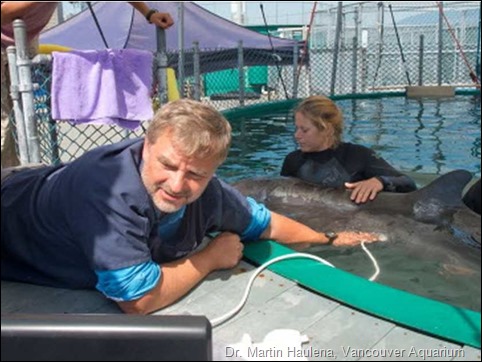In a recent article in the Vancouver Sun, Vancouver Aquarium veterinarian Martin Haulena and former SeaWorld trainer Mark Simmons claim that a concrete tank at an aquarium is a safer and better environment for whales than a seaside sanctuary. This is ironic in that the Vancouver Aquarium has just suffered the loss of two young beluga whales, a loss that Dr. Haulena and his colleagues have yet to be able to explain.
Dr. Haulena’s comments are all made in reference to sanctuaries as “sea pens.” But, as he knows very well, the Whale Sanctuary Project is not planning to build sea pens, which are small enclosures entirely unsuited to the long-term care of whales and dolphins. A seaside sanctuary, by comparison, is a large, deep habitat, created by netting off an entire cove or bay, using well-established engineering methods. It does not, in any way, resemble a sea pen.
 Regarding the other claims made by the aquarium:
Regarding the other claims made by the aquarium:
Dr. Haulena: “You have no environmental control. You cannot control for harmful algal blooms.”
Variation in environmental factors, including changes in water temperature, oil spills and algal blooms, are factors that are being fully taken into account by our expert team of veterinarians, marine mammal scientists, ocean scientists and animal welfare professionals as we consider the many possible sites for a seaside sanctuary.
Dr. Haulena: “Nets are a threat themselves to wild species and ecosystems.”
Not so. The kind of engineering with netting we plan is used by the U.S. Navy and by many marine parks and aquariums without problems.
Dr. Haulena: Human contact and socialization is limited … At the same time, caring for a sick or injured animal is almost impossible.
Our animal care staff will nurture close relationships with each resident and will interact with them on a regular basis. We will be conducting the same veterinary care procedures (e.g., taking blood, checking dentition, assaying hormones, etc.) that are done at the Vancouver Aquarium and other facilities that house cetaceans. We will employ training to ensure that there is communication between each resident and the care staff, and we will have round-the-clock observational data on each resident every day of the year to ensure their health and safety.
Nor will socialization with other whales be limited. Quite the opposite. Residents will have the opportunity to see and hear other residents, and, where possible, swim together. They will also be interacting with fish and other sea life occupying their ocean space.
Mr. Simmons: Life in a netted cove would be one of “isolation and deprivation.”
Mark Simmons claims that netted-off coves and bays for dolphins and whales would deprive the residents of stimulation. The opposite is, of course, the case. The cetaceans at Vancouver Aquarium and other marine parks currently live in shallow, barren concrete tanks with little social stimulation and no contact with the natural environment they evolved to thrive in. In an authentic seaside sanctuary, the residents will have orders of magnitude more space to swim and, importantly, dive to depths not possible in concrete tanks but vital to their well-being. They will experience the natural rhythms of a dynamic and rich ocean environment.
Dr. Haulena: “It would become SeaWorld by another name.”
Again, the opposite is the case. In an aquarium or marine park, the wellbeing of the animals is never the priority since these facilities have to concern themselves with “visitor experiences” and “ticket sales.” In a sanctuary, the wellbeing of the animal residents is the top priority and the entire enterprise is focused on that goal.
The very purpose of a sanctuary is to restore as much as possible of what has been taken from these animals in entertainment facilities